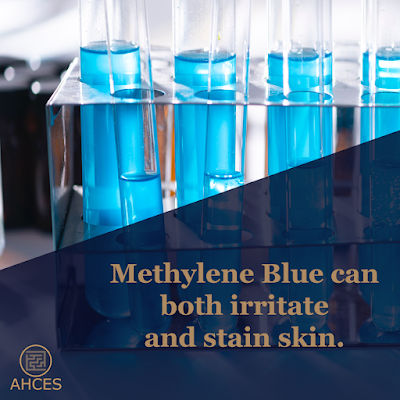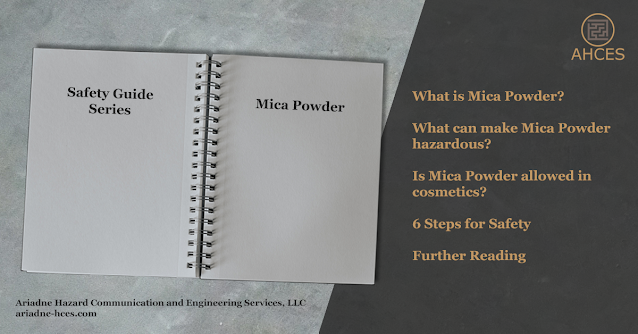Methylene Blue Safety Guide
What is Methylene Blue?
Methylene blue is an organic chloride salt, also known as methylthioninium chloride, tetramethylene blue, basic blue 9, and solvent blue 8. Methylene blue has many different uses, including as a disinfectant and anti-fungal in aquariums, a fabric dye, an organic stain in laboratories, and as an intravenous medicine for the treatment of methemoglobinemia.
Methylene Blue has the CAS Number 61-73-4.
The CAS Number is used to identify methylene blue as an ingredient on safety data sheets (SDS) and other safety documentation. When looking for methylene blue as an ingredient in products, look for the above CAS Number within the composition table.
Notable Properties of Methylene Blue
Methylene blue can be found in both a solid crystalline form and a liquid form dissolved in water or another solvent. Crystalline methylene blue is blue green in color with a bronze luster. Liquid methylene blue is dark blue.
What Makes Methylene Blue Hazardous?
Methylene blue is corrosive and correspondingly irritating to the skin, eyes, and mucous membranes.
Per the Hazardous Substances Data Bank, there is evidence that methylene blue is a teratogen and should not be administered to pregnant patients as it can cause fetal harm. There is also evidence of negative interactions between methylene blue and serotonin active agents.
Methylene blue is also listed on the EPA Chemicals under the Toxic Substances Control Act (TSCA) collection. Concentrated methylene blue can be hazardous to aquatic environments.
Methylene Blue Frequently Asked Questions
Is methylene blue harmful to humans?
As mentioned above, methylene blue is corrosive and contacting concentrated methylene blue can cause irritation to any body parts exposed. Additionally, methylene blue is a reported teratogen and may cause harm during fetal development.
Methylene blue can be used to treat certain health conditions, such as methemoglobinemia and has historical use as a treatment for malaria. Any use of methylene blue as a medicine should be done under proper medical supervision and as directed by a licensed medical professional.
Methylene blue should not be used in homeopathic practices.
Is methylene blue a carcinogen?
Per the International Agency for Research on Cancer, there is currently insufficient evidence to classify methylene blue being a human carcinogen or not.
Due to this status, methylene blue is not regulated as a human carcinogen.
6 Steps for Safety
Step 1: Read the Warnings
When working with a product for the first time, always read all the safety documents first. This includes safety data sheets, which should be provided by the manufacturer or importer of the methylene blue product. There may also be an EPA label, OSHA chemical label, or a Consumer Protection label on the packaging of the methylene blue product. These documents all contain important information on the hazards of the product and instructions on how to mitigate those hazards.
Different compositions in different products may cause additional hazards to be present beyond the properties of product with methylene blue as the only active ingredient. Be sure to familiarize yourself with the differences between separate methylene blue based products.
If taking methylene blue as a medication, be sure to follow all instructions given by a medical professional.
Step 2: Prepare Your Workspace
Creating a safe workspace, sometimes referred to as engineering control, is a key component of working safely with any potentially hazardous substance.
For example, if the methylene blue product is in solid form and dusty, then the dust will have to be kept under control. A fan which would blow dust particles around should be avoided. A dust collection with a filter to capture dust is recommended.
Since methylene blue is an environmentally hazardous substance, it is important that any spills can be kept contained and cleaned up without releasing the material into the environment. This includes having a spill cleanup kit available, with adsorbent material if the methylene blue is in liquid form.
Step 3: Gather Your PPE
For handling methylene blue in solid form, you will need
the following PPE.
- Respiratory Protection
- A filtering mask with an appropriate rating for the size of any methylene blue dust particles is recommended.
- Gloves
- Basic disposable gloves will prevent methylene blue from touching the skin on the hands and causing irritation.
- Long Sleeves
- Long sleeves will prevent methylene blue from touching the skin on the arms and causing irritation.
- Either a long-sleeved shirt, long-sleeved coat, or disposable sleeves will work.
- Launder any contaminated clothing separately to prevent cross-contamination and inform anyone laundering the clothing of the presence of methylene blue so they can take any necessary precautions.
For handling methylene blue in liquid form, you will need
the following PPE.
- Eye and Face Protection
- Either a face shield and safety glasses or a pair of safety goggles can prevent liquid methylene blue from contracting the eyes in the event of a splash.
- Gloves
- Basic disposable gloves will prevent methylene blue from touching the skin on the hands and causing irritation.
- Methylene blue will also stain the skin or other body surfaces it contacts.
- Body Covering
- Rubberized or otherwise non-porous coverings are recommended to prevent a liquid splash from contacting the body. This also protects the clothing worn underneath, as methylene blue solutions can stain organic fabrics, including cotton.
Step 4: Clear Your Workspace
Having a clear workspace is an important part of safety. Clutter can cause accidents and can prevent you from noticing if something has spilled.
This is also a good time to double-check any engineering controls are in proper working order and that necessary cleaning equipment, such as a spill kit, are readily at hand.
If you are working in a shared space, make sure anyone around you can also remain safe when you are working with methylene blue. For those working at home, this can include family members and pets.
Step 5: Do The Work
If engineering controls and PPE are used properly, working with methylene blue has minimal hazards.
Methylene blue is a highly effective stain and (the author speaking from personal experience) it will stain your skin for an extended period of time if there is a small hole in your glove. Carefully checking gloves worn and/or wearing two layers of gloves, is recommended.
If work cannot be completed in one sitting, be sure to properly seal any methylene blue containers to prevent spills or accidental release when not in use.
Step 6: Clean Up
Dust generation should be avoided when cleaning up solid methylene blue products. Either a vacuum with a filter or a damp cleaning cloth can be used to pick up spilled any stray solid cupric sulfate while preventing dust generation.
Be sure to dispose of any waste in accordance with local regulations.
As methylene blue is an environmentally hazardous substance, take extra precautions so that none is released into the environment during cleanup.
Further Reading
The National Library of Medicine has a PubChem Methylene Blue Summary. The American Chemical Society also featured Methylene Blue as a Molecule of the Week.
Check out the Safety Guide Series Hub for more safety guides.
Sources Cited
National Center for Biotechnology Information (2024). PubChem Compound Summary for CID 6099, Methylene Blue. Retrieved November 4, 2023 from https://pubchem.ncbi.nlm.nih.gov/compound/Methylene-Blue.
National Center for Biotechnology Information (2024). PubChem Annotation Record for , Methylene blue, Source: Hazardous Substances Data Bank (HSDB). Retrieved November 4, 2023 from https://pubchem.ncbi.nlm.nih.gov.
Original Posting Date: Nov. 4, 2023
Last Updated: Feb. 12, 2024






Comments
Post a Comment